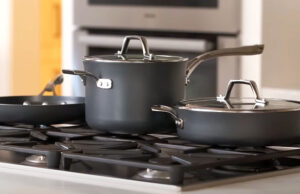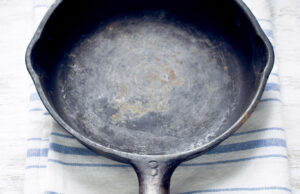Dutch ovens are one of the most versatile and beloved kitchen tools. From stews to braises, baking bread to roasting meat, they can do it all. But a common question many home cooks ask is, “Can you put a Dutch oven in the oven with the lid on?” Whether you’re a seasoned pro or new to cooking, this question might have crossed your mind. The answer might be simpler than you think, and I’m here to break it down for you in this ultimate guide. Let’s dive in and explore how to get the most out of your Dutch oven when using it in the oven!
What Is a Dutch Oven and Why Are They So Popular?
Before we dive into whether or not you can put the lid on a Dutch oven while cooking in the oven, let’s talk a little about what a Dutch oven is and why it’s so popular.
A Dutch oven is a heavy pot made from cast iron or sometimes enameled cast iron. These pots are perfect for slow-cooking dishes that need even heat distribution, making them great for dishes like soups, stews, chili, and even bread. Dutch ovens are loved for their ability to maintain heat for a long time, which means your food can cook evenly and thoroughly. They come in all sizes, and their versatility is a huge reason they’re a staple in many kitchens.
Now, when it comes to using a Dutch oven in the oven, there are a few things you should keep in mind. Let’s explore whether you can safely put the lid on your Dutch oven in the oven and why it can be important for certain recipes.
Can You Put a Dutch Oven in the Oven with the Lid On?
Yes, you can absolutely put a Dutch oven in the oven with the lid on! In fact, many recipes call for using the lid to trap moisture and heat inside, which helps the food cook evenly. The lid of a Dutch oven creates a sealed environment that keeps the steam and moisture inside, making it perfect for braising meat, baking bread, or making dishes like casseroles or pot roast.
When you put a lid on the Dutch oven and cook it in the oven, you create an environment similar to a slow cooker. The heat circulates inside the pot, cooking the food without letting moisture escape, keeping everything tender and juicy.
Why Should You Use the Lid in the Oven?
Here are a few reasons why using the lid is beneficial when cooking with a Dutch oven in the oven:
- Moisture Retention: As mentioned, the lid helps trap moisture inside the pot. This is especially useful when cooking dishes that require a lot of liquid, like stews or braises, because it prevents the liquid from evaporating and drying out your food.
- Even Cooking: The lid also helps to evenly distribute heat around the food. This is why Dutch ovens are so great for slow-cooking dishes—they cook your food from all sides, ensuring that everything is tender and perfectly cooked.
- Prevent Overbrowning: Some recipes, like bread, benefit from having the lid on during the first part of the cooking process. This helps prevent the top from overbrowning before the inside is fully cooked.
Are There Any Risks to Using the Lid in the Oven?
While using the lid is generally safe and beneficial, there are a few things to consider before popping your Dutch oven in the oven with the lid on:
- Check the Lid Material: Some Dutch oven lids are made from materials that are not oven-safe. Most modern Dutch ovens, especially enameled ones, come with lids that are oven-safe, but it’s always best to double-check. A lid with a plastic handle or knob may not be able to handle the heat of the oven. If your lid has a plastic knob, consider replacing it with a metal one for oven-safe cooking.
- Pressure Buildup: When cooking with the lid on, be mindful of how tightly the lid fits. If it’s too tight, pressure can build up inside the pot, which could be dangerous, especially if you open the lid suddenly and hot steam escapes. Always let the Dutch oven cool down for a bit before removing the lid to avoid burns.
- Temperature Limits: Be aware of the temperature limits for your specific Dutch oven. While most Dutch ovens can withstand temperatures of up to 450°F or more, always refer to the manufacturer’s instructions to ensure you’re not exceeding safe temperature limits.
In general, though, the lid helps create the perfect cooking environment for many types of dishes, making it an essential part of Dutch oven cooking.
Can You Use the Dutch Oven Lid for Baking Bread?
One of the most popular uses for a Dutch oven with a lid is baking bread. If you’ve ever looked up how to make artisan-style bread at home, you’ve probably come across the suggestion to bake it in a Dutch oven. But how does this work?
When you bake bread in a Dutch oven with the lid on, it traps steam inside, which creates a moist environment that helps the dough rise and gives the bread a beautiful, crispy crust. The heat from the Dutch oven ensures that the bread cooks evenly, while the lid prevents the dough from drying out.
The Science Behind Baking Bread in a Dutch Oven
The key to baking bread in a Dutch oven is the steam. When you add your dough to the hot pot and cover it with the lid, it traps the moisture from the dough. This steam helps the bread rise and gives it that perfect golden-brown, crispy crust.
Many bread recipes recommend preheating your Dutch oven in the oven before adding the dough. This creates a super-hot environment for the bread to bake in right from the start. Then, once you place the dough in, cover it with the lid, and bake for a set amount of time. Afterward, you remove the lid for the final bit of baking to allow the crust to crisp up.
Tips for Baking Bread in a Dutch Oven
- Preheat the Dutch Oven: For best results, preheat your Dutch oven in the oven. This will create a hot environment that helps the bread rise.
- Score the Dough: Before placing the dough in the Dutch oven, score the top with a sharp knife. This allows the bread to expand while baking, creating a beautiful, rustic look.
- Let it Cool: After baking, let the bread cool for at least 10-15 minutes before slicing. This helps the crumb set properly.
So, yes, the lid is an essential part of baking bread in a Dutch oven. Without it, you might miss out on that steamy environment that helps make the bread so delicious.
Final Thoughts
I hope this article helped you understand why and how you can put your Dutch oven in the oven with the lid on. Whether you’re baking bread or making a hearty stew, using the lid is a great way to enhance your cooking. Just make sure your lid is oven-safe, and always follow your recipe’s instructions for the best results.
Frequently Asked Questions
Is it safe to put a Dutch oven in the oven with the lid on?
Yes, it’s safe as long as the lid is oven-safe and made from suitable materials. Always check the manufacturer’s instructions before using it in the oven.
Can I use my Dutch oven lid for baking bread?
Absolutely! The lid is crucial for trapping steam when baking bread in a Dutch oven, which helps create a beautiful crust and a soft interior.
Do I need to preheat my Dutch oven before baking bread?
It’s recommended to preheat your Dutch oven for the best results when baking bread. It creates a hot environment that helps the dough rise properly.
Can I use a Dutch oven with a plastic handle in the oven?
No, plastic handles may not withstand high oven temperatures. Always make sure your Dutch oven is fully oven-safe before using it in the oven.
Is it necessary to use the lid when cooking in a Dutch oven?
While it’s not always necessary, using the lid helps retain moisture and heat, making it ideal for dishes like stews, braises, and baked goods.
Can a Dutch oven lid be used on a stovetop?
Yes, as long as the material of the lid is stovetop safe. Some lids, like those with a plastic handle, may not work well on high heat.
Do I need to adjust the cooking time when using a Dutch oven lid?
In some cases, yes. The lid can speed up cooking by trapping heat and moisture. Be sure to follow the recipe’s specific instructions for cooking times.
Is it okay to cook on high heat with the lid on?
You can cook on high heat with the lid on, but it’s important to ensure your Dutch oven is rated for high temperatures. Always follow the manufacturer’s guidelines.



